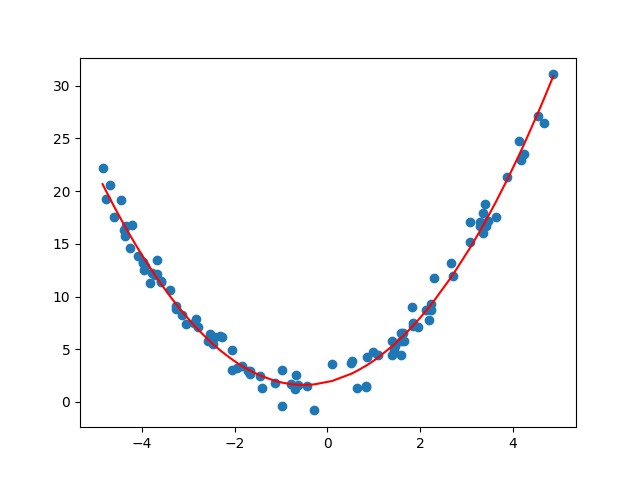使用sklearn进行多项式回归
1.数据
1 2 3 | x = np.random.uniform(-5, 5 ,size=100)X = x.reshape(-1, 1)y = x**2 + x +2 + np.random.normal(0, 1, size = 100) |
2. 拟合
1 2 3 4 5 6 7 8 | ploy = PolynomialFeatures(degree=2)X2 = ploy.fit_transform(X)reg = LinearRegression()reg.fit(X2,y)y_predict = reg.predict(X2)print(reg.coef_) #系数print(reg.intercept_) #截距 |
3. 图形绘制
1 2 3 | plt.scatter(x, y)plt.plot(np.sort(x), y_predict[np.argsort(x)], color='r')plt.show() |
拟合部分还可以通过Pipeline将 多项式生成,归一化处理,线性回归进行整合
1 2 3 4 5 6 7 8 9 10 11 | from sklearn.pipeline import Pipelinefrom sklearn.preprocessing import StandardScaler# 多项式的特征,数据归一化,线性回归poly_reg = Pipeline([ ("poly", PolynomialFeatures(degree=2)), ("std_scaler", StandardScaler()), ("lin_reg", LinearRegression())])poly_reg.fit(X, y)y_predict = poly_reg.predict(X) |
系数: [0. 1.02750451 1.00863466]
截距:1.8723913311785978





【推荐】国内首个AI IDE,深度理解中文开发场景,立即下载体验Trae
【推荐】编程新体验,更懂你的AI,立即体验豆包MarsCode编程助手
【推荐】抖音旗下AI助手豆包,你的智能百科全书,全免费不限次数
【推荐】轻量又高性能的 SSH 工具 IShell:AI 加持,快人一步
· 震惊!C++程序真的从main开始吗?99%的程序员都答错了
· winform 绘制太阳,地球,月球 运作规律
· 【硬核科普】Trae如何「偷看」你的代码?零基础破解AI编程运行原理
· 上周热点回顾(3.3-3.9)
· 超详细:普通电脑也行Windows部署deepseek R1训练数据并当服务器共享给他人